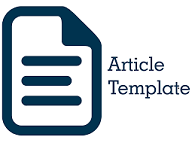Improving Mathematics Students’ Learning Motivation with the Guidelines Method of Household Engineering Techniques in Vocational School
Abstract
This research is motivated by the observations of researchers when teaching, it was found that there are still many students who experience obstacles when solving row problems. This type of research is qualitative research with descriptive research type. The approach and type of study were chosen according to the researcher's goal which is to describe the students' algebraic thought processes in solving the problem of ranks. The findings in this study, namely high ability students can go through each stage of problem-solving as well as doing the algebraic thinking process well, while moderate and low ability students still often ignore the stage of looking back. They also still have difficulty doing the algebraic thought process. The algebraic thinking process of high-ability students is more complex than students of medium and low ability. Highly capable students experience the process of gathering ideas, clarifying ideas, evaluating ideas, and making decisions over and over again in the thought process he does in solving problems. Besides that, in the process of thinking, high-ability students also observe patterns, make generalizations, use meaningful symbols, use functions, and make mathematical models.
Full Text:
PDFReferences
Aini, N., Wahyuni, S., & Totalia, S. A. (2018). Pengaruh Kualitas Pengajaran Guru dan Kebiasaan Belajar Siswa terhadap Prestasi Belajar Mata Pelajaran Ekonomi pada Siswa di SMA Negeri 6 Surakarta Tahun Ajaran 2017/2018. BISE: Jurnal Pendidikan Bisnis Dan Ekonomi, 4(1), 1–19. Retrieved from http://jurnal.fkip.uns.ac.id/index.php/ptn/article/download/12180/8663
Anggraini, I. S. (2011). Motivasi Belajar dan Faktor-Faktor yang Berpengaruh: Sebuah Kajian pada Interaksi Pembelajaran Mahasiswa. Premiere Educandum: Jurnal Pendidikan Dasar Dan Pembelajaran, 1(2), 100–109. https://doi.org/10.25273/pe.v1i02.39
Arikunto, S. (2002). Prosedur Penelitian Suatu Pendekatan Praktek. Jakarta: Rineka Cipta.
Arikunto, S. (2006). Penelitian Tindakan Kelas. Jakarta: Bumi Aksara.
Budisiwi, H., Rozano, D., & Purwati, D. (2016). Upaya Peningkatan Motivasi Belajar Melalui Layanan Bimbingan Kelompok dengan Pendekatan Behavioristik. Jurnal Penelitian Tindakan Bimbingan Dan Konseling, 2(1), 43–48. Retrieved from https://i-rpp.com/index.php/jptbk/article/download/420/410
Damis, D., & Muhajis, M. (2018). Analisis Hubungan antara Motivasi Belajar dengan Hasil Belajar Siswa pada Sekolah Dasar Negeri 3 Allakuang Kecamatan Maritengngae Kabupaten Sidenreng Rappang. Idaarah: Jurnal Manajemen Pendidikan, 2(2), 216–228. https://doi.org/10.24252/idaarah.v2i2.7005
Halidi, H. M., Husain, S. N., & Saehana, S. (2015). Pengaruh Media Pembelejaran Berbasis TIK terhadap Motivasi dan Hasil Belajar IPA Siswa Kelas V SDN Model Terpadu Madani Palu. E-Jurnal Mitra Sains, 3(1), 53–60. https://doi.org/10.22487/j23022027,2015.v3.4153
Harahap, F. A. (2017). Hubungan Sumber Belajar dan Motivasi Belajar dengan Hasil Belajar Pendidikan Agama Islam di SMP Negeri 3 Binjai. At-Tazakki: Jurnal Kajian Ilmu Pendidikan Islam Dan Humaniora, 1(1), 1–20. Retrieved from http://jurnal.uinsu.ac.id/index.php/attazakki/article/download/841/632
Huda, M. (2017). Kompetensi Kepribadian Guru dan Motivasi Belajar Siswa (Studi Korelasi pada Mata Pelajaran PAI) Mualimul. Jurnal Penelitian, 11(2), 237–266. https://doi.org/10.21043/jupe.v11i2.3170
Manizar, E. (2015). Peran Guru sebagai Motivator dalam Belajar. Tadrib: Jurnal Pendidikan Agama Islam, 1(2), 171–188. Retrieved from http://jurnal.radenfatah.ac.id/index.php/Tadrib/article/download/1047/883/
Muhasim, M. (2017). Pengaruh Tehnologi Digital terhadap Motivasi Belajar Peserta Didik. Palapa, 5(2), 53–77. https://doi.org/10.36088/palapa.v5i2.46
Prayitno. (1995). Layanan Bimbingan dan Konseling kelompok (Dasar dan Profil). Jakarta: Ghalia Indonesia.
Romlah, T. (2016). Teori dan Praktek Bimbingan Kelompok. Malang: Universitas Negeri Malang.
Sardiman, A. M. (2005). Interaksi dan Motivasi Mengajar. Jakarta: Grasindo.
Sukardi, D. K. (2008). Pengantar Pelaksanaan Program Bimbingan dan Konseling di Sekolah. Jakarta: Rineka Cipta.
Suparti. (2008). Model-model Therapi. Yogyakarta.
Suwarjo, S., & Surur, N. (2016). Modul Guru Pembelajar Bimbingan dan Konseling Sekolah Menengah Atas/Sekolah Menengah Kejuruan (SMA/SMK) Kelompok Kompetensi I Pedagogik: Esensi Pelayanan BK pada Jenjang Pendidikan. Jakarta: PPPPTK Pendidikan Jasmani dan Bimbingan Konseling.
Tohirin. (2007). Bimbingan Konseling di Sekolah dan Madrasah. Jakarta: Raja Grafindo Persada.
Tubagus, M. (2013). Pengembangan Media Internet untuk Meningkatkan Motivasi dan Hasil Belajar Mahasiswa Sya’riah Stain Manado. Jurnal Ilmiah Iqra’, 7(2), 1–25. https://doi.org/10.30984/jii.v7i2.609
Winardi. (1992). Manajemen Perilaku Organisasi. Bandung: Citra Aditya Bakti.
Yamin, M. (2007). Kiat Mempelajari Siswa. Jakarta: Gaung Persada Press.
DOI: https://doi.org/10.24036/kolokium-pls.v7i2.351
Refbacks
- There are currently no refbacks.

